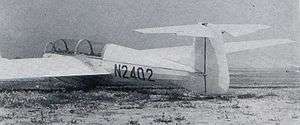Bartos/Nobel BN-1 Phantom
| BN-1 Phantom | |
|---|---|
 | |
| Bartos/Nobel BN-1 Phantom | |
| Role | Glider |
| National origin | United States |
| Designer | Gene Bartos |
| Introduction | late 1960s |
| Status | Production complete |
| Number built | One |
| Developed from | Laister-Kauffman TG-4 |
The Bartos/Nobel BN-1 Phantom is an American, two-seat, mid-wing glider designed by Gene Bartos in the late 1960s.[1][2]
Design and development
Bartos developed the BN-1 using the fuselage from a Laister-Kauffman TG-4 and designing new wings. The fuselage was highly modified to include an all-flying T-tail and new cockpit canopy. The wings have a 9 ft (2.7 m) greater span than the TG-4 using a NACA 44-series airfoil. The new wing uses top-surface spoilers in place of flaps. The new wing results in a glide ratio improved from 22:1 to 25:1.[1]
The fuselage is made from steel tube, while the wings are of wooden construction, all finished with doped aircraft fabric covering. The landing gear is a fixed monowheel, supplemented by a nose skid.[1]
Operational history
In 1983 it was reported that the sole example had been based at El Mirage, California since it was new and was regularly flown. By April 2011 the aircraft had been de-registered by the Federal Aviation Administration.[1][2]
Specifications (BN-1)
Data from Soaring[1]
General characteristics
- Crew: one
- Capacity: one passenger
- Wingspan: 59 ft 0 in (17.98 m)
- Wing area: 200 sq ft (19 m2)
- Aspect ratio: 15:1
- Airfoil: NACA 4415 reflexed
- Empty weight: 680 lb (308 kg)
- Gross weight: 1,030 lb (467 kg)
Performance
- Maximum glide ratio: 25:1
- Wing loading: 5.0 lb/sq ft (24 kg/m2)
See also
References
- 1 2 3 4 5 Said, Bob: 1983 Sailplane Directory, Soaring Magazine, page 36. Soaring Society of America November 1983. USPS 499-920
- 1 2 Federal Aviation Administration (April 2011). "Make / Model Inquiry Results". Retrieved 25 April 2011.